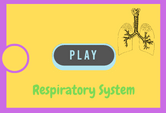Respiratory System Game Quiz Online
This page features a Respiratory System Game Quiz Online. It is an exercise for students studying science in 3rd, 4th, 5th, 6th to 8th grades. Students will learn about respiratory system. Play this game and learn about it.

Quick – take a deep breathe. Inhale. Now, exhale. What you’ve just done couldn’t have been possible without the presence of your respiratory system. Although you usually aren’t aware of your respiratory processes as you go about your day, their work is vital to keeping you alive.
For such an important system of the body, how much do you actually know about your respiratory system?
The Major Parts of the Respiratory System
The principal organ of the respiratory system is the lungs. The human Respiratory System is made up of several organs that enable us to breathe. Some of the important organs of the respiratory system common to animals include the lungs, skin, gills, and trachea. Listed below are some of the major parts of the Human Respiratory System. If you have trouble identifying which part of the respiratory system is responsible for breathing, don't worry! We'll cover them all in the following sections.
- Inhalation
Inhalation in the respiratory system occurs as the diaphragm pulls downward and pushes on the lungs, creating a vacuum and allowing air to enter. The respiratory system is equipped with built-in mechanisms to keep out harmful substances, but inhaling cigarette smoke can damage these systems. The lungs contain air-filtering hairs that trap large particles. Cilia move in sweeping motions to keep the air passages clean.
As air enters the lungs, it fills the alveoli. The oxygen then moves from the alveoli to the bloodstream through the capillaries that line the alveolar walls. When oxygen reaches the bloodstream, it binds with hemoglobin molecules in red blood cells and travels throughout the body. As you exhale, the blood carries carbon dioxide back to the alveoli.
- Lungs
The lungs are a pair of conical organs. They are made up of airways called bronchi, which branch into smaller ones called bronchioles. The airways are also divided into tiny sacs called alveoli, which exchange oxygen and carbon dioxide. The lungs are located in the chest, behind the rib cage, and have a roughly conical shape with a pointy apex and a flatter base where they meet the diaphragm.
There are two lungs in the respiratory system. The right lung is located on the right side of the body, while the left lung is on the left. The right lung has three lobes, two bronchi, and a larger volume than the left lung. The right lung is also larger than the left lung, and its base is less concave. Both lungs are made of soft, elastic, spongy tissues and contain alveoli, where gas exchange occurs.
- Nasal cavity
The nasal cavity in humans is surrounded by the frontal sinuses and the ethmoid sinus. These air-containing cavities are named for the bones that support them. The air-filled spaces produce mucus and help to lighten the weight of the skull. The nares and anterior nasal cavities are lined with mucous membranes and contain glands and hair follicles. The olfactory epithelium is located in the deeper portions of the nasal cavity.
The anterior part of the nasal cavity is lined with stratified squamous epithelium, which extends through the ventral meatus into the pharynx. This layer contains ciliated columnar cells as well as cuboidal, goblet, and brush cells. The lateral walls of the respiratory system are lined with transitional respiratory epithelium composed of cuboidal and un-ciliated columnar cells.
- Bronchi
The bronchi of the respiratory system are a major pathway for air to travel from the lungs to the alveoli. They are lined with simple squamous epithelium, which allows rapid diffusion of both oxygen and carbon dioxide. Bronchitis is a common respiratory ailment and can be caused by viral or bacterial infections, smoking, or long-term exposure to irritants.
The bronchi branch out into smaller airways called bronchioles. These bronchioles are smaller than 2/100 of an inch, resembling an upside-down tree. The large airways are held open by semi-flexible cartilage, while the smaller ones are supported by lung tissue. The walls of the smaller airways are lined with a thin layer of smooth muscle, which can relax and change the size of the airway.
The bronchi protect the body from harmful substances in the air. While most of these substances pass through the nose, some become trapped inside the lungs. The lungs produce a thick, slippery fluid called mucus to trap these substances and destroy them. The mucus is pushed through the bronchi by the cilia, which move rapidly, and is removed by coughing and swallowing. While these lungs are important, they don't have a lot of room for movement.
